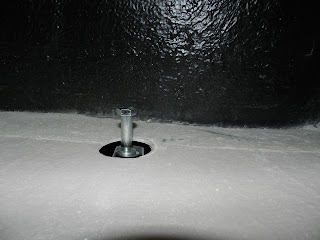I have decided not to replica an old Cobra dashboard look or the standard GD layout. For example, I do not want the counterclockwise speedo and the usual GD pyramid style layout of gauges is not to my liking. So I have gone for a mix of Lucas type switches, modern billet alloy switches, warning lights with silver bezels and gauges that are a mix of traditional and more modern. Sounds dreadful when you write it down!
Switches and warning lights
What I have bought is:
Push button start - momentary
Push button hazard - latching
Flick switch for fog light - on/off
Flick switch for heater - on/on/off
Flick switch for lights - on/on/off
Indicator light warning - left
Indicator light warning - right
Brake warning
Battery warning
Fog light warning
Main beam warning
Gauges
What I do want is to have kph shown alongside mph on the dial, in case I drive abroad. I also want black background gauges, with red pointers and IVA compliant bezels. Originally I was going to go with white backgrounds, but Carol (my wife) thought that they didn't look as good as black ones.
 |
| The ETB speedo with mph and kph |
I have decided on ETB gauges, as they can be configured as I want, are a good price and delivery timescales are relatively short.
I will have the following gauges a speedo, rev counter, oil temperature, oil pressure, water temperature, voltmeter and a fuel gauge.
Sensors
I need some specific sensors and adaptors, so I had to identify where these went and the thread sizes before I could place the order! John Gare at ETB was a great help here (see link on right), as was Dave Hampshire at Canems. LS1tech.com is usually very good at helping sort out these things, but this time the posts were just confusing - everyone seemed to have a different view of where the sensors were located and what the thread size was.
What I eventually concluded for my LS6, was that two adaptors were required for the temperature sensors (water and oil). These are M12 x 1.5 threads to take 1/8" NPT sensors, one located at the rear of the offside head (water) and the other above the oil filter on the nearside. This tied up with what John Gare at ETB had said. The existing water temperature sensor is still used as well.
 |
| Existing water temperature sensor |
 |
| New water temperature sensor position at rear offside |
|
|
| Old oil temperature sensor |
My next challenge was to work out where the oil pressure sensor went. This turned out to be at the back of the engine on the nearside and the near the valley (it was blocked off with a big grub type screw) and needs a M16 x 1.5 threaded adaptor, to take a 1/8" NPT sensor. Again the size of the thread tied up with what John at ETB had said.
 |
| Where the oil pressure sensor will go |
The fuel sensor will be a dip tube (this will match the gauge electrically), rather than the float arm type. This is a VDO product and works by having a float that moves up and down inside the dip tube. This is apparently more accurate, but a little more expensive. The dip tube needs to be the depth of the tank, less about 4 mm and also allow for the reserve fuel! So I decided on a 260mm dip tube after a lot of calculating.
 |
| Fuel sensor dip tubes |
Order placed
So I have ordered the following gauges:
- Speedometer
- Tachometer (rev counter)
- Fuel gauge (compatible with a dip tube)
- Oil temperature
- Oil pressure
- Water temperature
- Voltmeter
And the following sensors with adapters:
- Oil temperature
- Oil pressure
- Water temperature (additional)
- Fuel sensor (dip tube) 260mm long









































